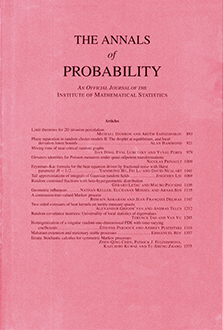Abstract
We introduce a technique using nonbacktracking random walk for estimating the spectral radius of simple random walk. This technique relates the density of nontrivial cycles in simple random walk to that in nonbacktracking random walk. We apply this to infinite Ramanujan graphs, which are regular graphs whose spectral radius equals that of the tree of the same degree. Kesten showed that the only infinite Ramanujan graphs that are Cayley graphs are trees. This result was extended to unimodular random rooted regular graphs by Abért, Glasner and Virág. We show that an analogous result holds for all regular graphs: the frequency of times spent by simple random walk in a nontrivial cycle is a.s. 0 on every infinite Ramanujan graph. We also give quantitative versions of that result, which we apply to answer another question of Abért, Glasner and Virág, showing that on an infinite Ramanujan graph, the probability that simple random walk encounters a short cycle tends to 0 a.s. as the time tends to infinity.
Citation
Russell Lyons. Yuval Peres. "Cycle density in infinite Ramanujan graphs." Ann. Probab. 43 (6) 3337 - 3358, November 2015. https://doi.org/10.1214/14-AOP961
Information





